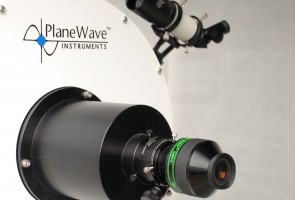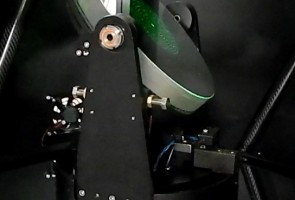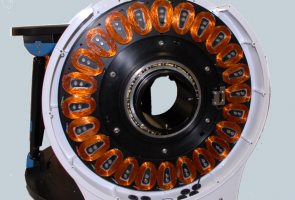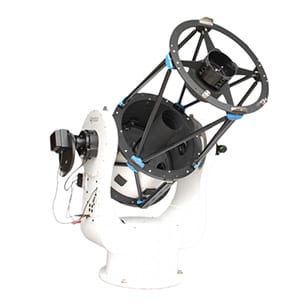CDK700 Observatory System
Price: $195,000.00
*Price is based on PlaneWave’s Pricing Policy
Enjoy exceptional performance for astrophotography, research, or visual observing with the CDK700!
- f/6.5 and 4540mm focal length providing pinpoint stars across a 70mm image circle.
- No coma, no off-axis astigmatism, and no field curvature.
- Compact Alt/Az design with dual Nasmyth ports allowing multiple instrumentation payloads to be installed on the telescope.
- Integrated direct drive mount with optical encoders, zero periodic error, zero backlash, and minimal maintenance due to the lack of gears.
- Slew speeds up to 50 degrees/sec for satellite tracking and fast target acquisition.
- Fast 1 day installation and on-sky taking images that same night (weather dependent).
Description
Comes with fused silica mirrors on all CDK and RC models
The CDK700 is a complete observatory class telescope and direct-drive alt-azimuth mounting system, designed and engineered by PlaneWave. With a 70 mm image circle, the CDK700 is designed to excel at imaging on large format CCD cameras. The optical system utilizes a Nasmyth focus through both altitude bearings allowing your camera or eyepiece to remain at a fixed height while holding heavy instruments without needing to rebalance the optical tube assembly.
Instrumentation can be installed on both sides of the fork mount and easily accessed using the included rotating tertiary mirror system. With direct-drive motors, high resolution encoders, and zero backlash or periodic error, the CDK700 set the standard for commercially produced research telescopes.
CDK700 Features
- Pinpoint stars out to a 70mm image circle
- Ultra-low thermal expansion fused silica optics
- Dual Nasmyth focus, allowing simultaneous mounting of two instruments or easy switching between visual and imaging use
- Direct-drive motors on each axis for smooth, fast, and virtually silent movement of the telescope
- High resolution encoders on each axis for precise positioning
- Zero backlash
- Zero periodic error
- PointXP mount modeling software
- Field de-rotator / rotational field framing
An alt/az mount is inherently more stable than an equatorial mount since there is no cantilevered mass, nor are there any large protruding counterweights to create a dangerous hazard in a public observatory. An alt/az telescope is also considerably more compact than its equatorial counterpart, allowing a larger telescope to fit in a smaller enclosure. The mass it takes to make a rigid alt/az mount is substantially less, leading to cost savings. Unlike German Equatorial mounts, there are no meridian flips to deal with. You can image from horizon to horizon continuously if desired. Alt/Az is more intuitive to use and no polar alignment is needed. Besides, it is the way the professionals do it!
Benefits of Nasmyth FocusThe Nasmyth Focus is along the altitude axis so there are virtually no balancing issue as you change out equipment. Eyepieces remain at a constant wheelchair-accessible height, greatly simplifying access to the telescope for public observatories. The rotating tertiary mirror allows you to switch from one Nasmyth port to the other in just seconds, allowing observers to easily transition between imaging and visual use. |
 |
Rotating Tertiary MirrorThe CDK700 includes an integrated rotator for the tertiary mirror, with magnetic locks to position the mirror precisely for either Nasmyth focus position. The rotator can move from one port to the other in under 10 seconds. Checkout the tertiary mirror video here. |
 |
Direct drive motors and encodersDirect Drive motors mean that there are no gears to cause backlash and periodic error. With high-resolution encoders providing the feedback for the direct drive motors, not only will the telescope track without periodic error or have any backlash at all, but the mount will be able to counter against wind gusts. The direct drive motors can move the telescope at incredible speeds for tracking satellites or just to minimize target acquisition time. |
 |
CDK Optical Design:
The CDK (Corrected Dall-Kirkham) Optical Design is an innovative solution for unsurpassed astroimaging quality at an affordable price. The CDK telescope design provides excellent imaging with large-format CCD cameras while remaining superb for visual use. The CDK design far exceeds the off-axis performance of most commercial telescope designs including the Ritchey-Chrétien design.
Our design produces a flat, coma-free, and astigmatic-free field of view. Since the secondary mirror is spherical, centering is very forgiving. This means it is easy to get the telescope optics aligned for optimum performance, which is not the case for most high-end astrographs. The end result at the image plane of the CDK design is no off-axis coma, no off-axis astigmatism, and a perfectly flat field all the way out to the edge of a 70mm image circle. All this means is that the stars will be pinpoints from the center of the field of view out to the corner of the field of view.
Specifications
Specifications
Optical System
| Optical Design | Corrected Dall-Kirkham (CDK) |
| Aperture | 700 mm (27.56 in.) |
| Focal Length | 4540 mm |
| Focal ratio | f/6.5 |
| Central Obstruction | 47% of the Primary Mirror |
| Back Focus from Mounting Surface | 309 mm (12.2 inch) |
| Weight | 1,200 lbs (544 kg) |
| Optical Tube | Dual truss structure with Nasmyth focus |
| Optical Performance | 1.8 micron RMS spots [25mm on-axis] (400 to 900nm) 4.4 micron RMS spots [21mm off-axis] (400 to 900nm) 6.8 micron RMS spots [35mm off-axis] (400 to 900nm) Spot Diagram. |
| Dimensions | 93.73″ H x 43.25″ W x 39″ D (Drawing here). |
| Focus Position | Nasmyth Focus |
| Image Scale | 22 microns per second |
| Fully Baffled Field | 60 mm |
| Optimal Field of View | 70 mm (0.68 degrees) |
Mechanical Structure
| Fork Assembly | Single piece U-shaped fork arm assembly for maximum stiffness |
| Azimuth Bearing | 20-in. diameter thrust bearing |
| Altitude Bearing | 2 x 8.5 in. OD ball bearings |
| Optical Tube | Dual truss structure with Nasmyth focus |
Motion Control
| Motor Control | Industrial grade Parker brushless motor control system and built in electronics |
| Azimuth Motor | Direct Drive 3 Phase Axial-Flux Torque Motor |
| Altitude Motor | Direct Drive 3 Phase Axial-Flux Torque Motor |
| Encoder – Azimuth and Altitude | 10 inch disk built into the azimuth and altitude axes with stainless steel encoder tape on the circumference with reader yields 16 million counts per revolution of the telescope. This translates to about 0.08 arcsecond resolution. |
| Motor Torque | Approximately 30 ft-lbs continuous; 60 ft-lbs peak |
| Drive Electronics | Capable of controlling up to 4 high speed encoders, limit switch inputs, homing switch inputs, controls two additional motors for accessories, two brake outputs and 16 digital and 2 analog inputs |
| Telescope Control Software | Incorporates PointXP mount modeling software by Dave Rowe All ASCOM compatible. MaxIm DL is required for camera control when building a pointing model within our PWI2 software. |
System Performance
| Pointing Accuracy | 10 arcsecond RMS with PointXP Model |
| Pointing Precision | 2 arcsecond |
| Tracking Accuracy | <1 arcsecond error over 10-minute period |
| System Natural Frequency | 10 Hz or greater |
| Field De-Rotator Accuracy | 3 microns of peak-to-peak error at 35mm off-axis over 1 hour of tracking (18 arcseconds) |
Primary Mirror
| Radius of Curvature | 4115mm |
| Optical Diameter | 700 mm (27.56 inch) |
| Outer Diameter | 714.38 mm (28.125 inch) |
| Core Diameter | 203mm (8 inch) |
| Material | Fused silica (quartz) |
| Edge Thickness | 2.25 inch |
| Cell | 18 point |
Secondary Mirror
| Radius of curvature | 2961 mm |
| Thickness | 25 mm |
| Optical Diameter | 312.4 mm (12.3 inches) |
| Outer Diameter | 317.5 mm (12.5 inches) |
| Material | Fused silica (quartz) |
| Cell | 3 point RTV |
Tertiary Mirror
| Optical Major Diameter | 152.4 mm |
| Thickness | 25 mm |
| Material | Fused silica (quartz) |
NOTE: All specifications and dimensions are subject to change.
Included Items
Included Items
| Heating elements for dew prevention | The heating pads on the primary and secondary mirror require the 600195 Delta-T controller sold separately |
| OTA Cover | To protect the primary mirror and inside of the optical tube |
| Flashdrive | Contains software and instructions for collimation and spacing the primary to secondary mirror |
| EFA Kit and IRF90 | Port one includes an IRF90 and EFA kit for focusing and derotating within PWI2 software and also relaying mirror temperature data back to the control computer. |
Recommended Accessories
Recommended Accessories
OTA Accessories
- Reducer 0.7x CDK700 (700166)
- IRF90 – Intergrated Rotating Focuser (600180)
- Electronic Focus Accessory (EFA) Kit (240901-KIT)
- EFA Mounting Bracket for CDK700 – (Required for EFA Kit)
- CDK700 Fabric Shroud (700970)
- Counterweight for 3/8-16 Female-Thread (600134)
Observatory System Accessories
Visual Accessory Package – (Items sold individually)
Gallery
Gallery
Downloads
Downloads
Drawings and Diagrams
Instruction Manuals
Warranty
Warranty
For warranty information please check our Standard Warranty Page.
